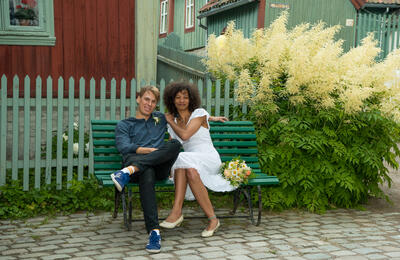Skikken med å kaste mynter i fontenebasseng er gammel. Når mynten kastes ønsker mange seg god helse, lykke og et langt liv, og mynten i bassenget er en takk for rent drikkevann. Et mer romantisk ritual er når mynter kastes i fontenen med håp om enten forelskelse eller ekteskap.
Hvem som i sin tid bestilte støpejernfontenen Femme Lampadaire hos firmaet A. Durenne i Paris er ukjent for oss og hvor den i 1870-årene var tenkt plassert vet vi heller ikke. Antakeligvis skulle den pryde en park eller en offisiell hage. Vi tenker slik fordi den ble malt grønn, datidens motefarge på fontener utendørs i offentlige rom. Via en antikvitetshandler i London kom den til Norge, og ble gitt i gave til Norsk Folkemuseum i anledning museets 100-års jubileum i 1994.
I historisk sammenheng har vannfontener og lysfontener hatt livsnødvendige og viktige funksjoner. Rennende rent drikkevann har forhindret sykdom og belysning på torg og i parker har gitt trygghet. Samtidig skulle fontenene pryde og forskjønne omgivelsen. Det har vært vanlig å formgi fontener etter sin samtids romantiske idealer, der kvinne- og mannsskikkelser hører naturlig inn sammen med vannet.
Vann knyttes til følelser og opplevelser. Mange erfarer at lyder fra rennende og sildrende vann virker beroligende, gir livsenergi, og oppmuntrer til ny giv og forandring. Lyden fra vann kan muligens både lindre kjærlighetssorg og kvikke opp forelskelsen? Vannet oppleves både som noe mykt og noe kraftfullt. En del fontener, kilder og brønner sies å ha magisk kraft. De kan oppfylle ønsker. Om vannet i museets fontene har magisk virkning på kjærligheten og oppfyller kjærlighetsønsker skal vi ikke påstå. Men om du og den du har et godt øye til drikker vann fra fontenen og blir forelsket? Da må vi vel kunne si at fontenevannest magi virket perfekt?
The Fountain – Fontana di Folkemuseet
The tradition of tossing coins into fountains basins is ancient. When coins are thrown, many wish for good health, happiness, and a long life, while the coins in the basin serve as a thank-you for clean drinking water. A more romantic ritual occurs when coins are tossed into the fountain with hopes of either falling in love or getting married.
Who originally ordered the cast-iron fountain Femme Lampadaire from the company A. Durenne in Paris is unknown to us, as is its intended location in the 1870s. It was likely meant to adorn a park or an official garden. We think this because it was painted green the fashion color for outdoor fountains in public spaces at that time. The fountain came to Norway via an antique dealer in London and was gifted to the Norwegian Museum of Cultural History in celebration of the museum’s 100th anniversary in 1994.
Historically, water fountains and light fountains have had life-sustaining and important functions. Flowing clean drinking water has prevented disease, while lighting in squares and parks has provided safety. At the same time, fountains were meant to adorn and beautify their surroundings. It has been common to design fountains according to the romantic ideals of their time, where female and male figures naturally belong with the water.
Water is associated with emotions and experiences. Many find that the sounds of flowing and trickling water have a calming effect, provide vitality, and encourage renewal and change. The sounds of water may possibly soothe heartache as well as invigorate feelings of love? Water is perceived as both something soft and something powerful. Some fountains, springs, and wells are said to possess magical powers. They can fulfill wishes.
Whether the water in the museum’s fountain has a magical effect on love and fulfills romantic wishes, we can’t say for sure. But if you and the person you have a crush on drink water from the fountain and end up falling in love, then we might say that the magic of the fountain water worked perfectly!

